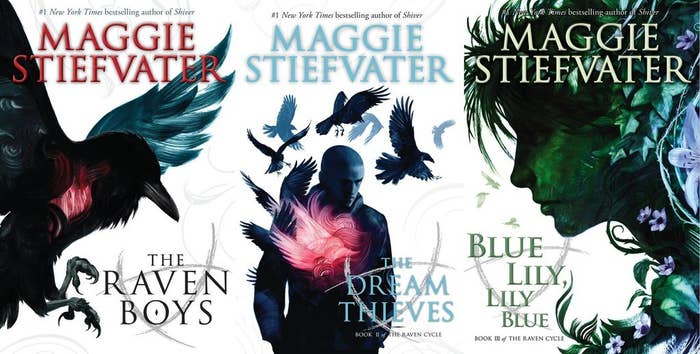
Depending on when you ask her, Maggie Stiefvater might describe her four-part Raven Cycle as a series about Welsh kings and fast cars, or she might describe it as a series about what makes a hero a hero. Because at its core, The Raven Cycle is about four private-school boys in Virginia, the girl they befriend, and the intricacies of navigating those relationships. But it's also a fantasy series, because this girl happens to be the youngest in a family of psychics, and she and the four boys go on an adventure to wake the centuries-old Welsh king Glendower because he is said to grant a wish to the person who completes this task. He's buried on something called a ley line, and there are magical forests and psychic visions and fast cars and unforeseen powers threaded together with a haunting, mystical aura.
The first three installments (The Raven Boys, The Dream Thieves, and Blue Lily, Lily Blue) are in stores now, and Stiefvater is hard at work on the final installment, so now's the time to catch up. Here's why:
1. The Raven Cycle is the type of book Stiefvater herself always wanted to read: a fantasy thriller.

In a phone interview with BuzzFeed last month, Stiefvater recounted how The Raven Cycle is ultimately born of her interests. She begins speaking at a fast clip, lightly flavored by the Virginia drawl that marks her current home. "I started writing when I was really small. They were terrible novels about dogs test-driving cars. I mean, they were really terrible novels. But I wrote dozens and dozens, and I was a big reader at the same time and my mom used to give me these award-winning fantasies with these award-winning stickers on the front, and I loved them. And then my father gave me his hand-me-down thrillers that were called things like Shot in the Back or Point Blank, and they were just terrible thrillers and I loved them too. I always thought the ideal book was those two things combined, and so that's what I was trying to do with The Raven Cycle."
2. It’s proof that the best things can take time.
Stiefvater, 33, first started writing The Raven Cycle when she was 19 and knew this much: She wanted it to include a king who's been asleep for centuries, Welsh mythology, and a rich boy who was trying to find his purpose by waking the king. And she wanted it all to take place in Virginia, because that was where she lived. "[But] I was a professional put-things-offer when I was 19," Stiefvater said. "I used to get into ideas and then as soon as I got stuck or they would get too hard I would just put them down and then start another one. What really killed me [about The Raven Boys] was that it had millions and millions of characters in it, and I knew I couldn't juggle them all, so I put them down."
So, instead of forcing The Raven Boys, Stiefvater worked on other novels that would wind up helping her successfully return to this project. She said her werewolf trilogy, Shiver, taught her how to break mythology up into digestible pieces, and the stand-alone novel Scorpio Races, about water horses involved in a dangerous race, taught her how to tell a tale with many characters.
But it was reading The Time Traveler's Wife that was a real turning point. "[It's] a time-travel novel that has nothing to do really with time travel. I don't think I ever realized before I read that book that you could take the pieces out of a legend that you didn't need and really get rid of it and strip it down," she said of the novel that enabled her to parse the richly complex history and mythology that already existed around her story into a new world of her creation.
3. It’s a love letter to Virginia.

Stiefvater's prose is deliberate, lush, and evocative, whether she's describing her characters (more on that in a sec), her mythology or — especially — her setting. Stiefvater was born in Virginia, but then, because her father was in the Navy, she moved, as she puts it, "Eighteen times before I was 18." She returned to the state to buy a home, coincidentally finding one two miles away from where she spent her childhood summers. "That was part of [why I set the Raven Cycle in Virginia]: I feel really at home here, even though it hasn't been my home for a long time," she said.
It's not just Stiefvater that feels the pull, as she shared in this story: "I was standing on the front porch [of my house], holding a disastrous children's party, and one of the parents was standing there. He was from Louisiana, and he looks out — and he's just an ordinary dentist — and he says, 'Yeah, we came here because my wife was from here and then, well, you know how it is, there's no crime here, the school is good…' And he goes, 'And the mountains. They want you.' It was such a shocking thing to hear come out of the mouth of this guy who before had been talking pragmatic adult things, and here were these mountains that wanted him, and I thought, Yes! That is the reason why I set these books here. It's so timeless here. Gansey talks about it a lot in the books and that was something I was trying to capture. You could drive through the valley and you can't tell if it's 1920 or if it's 2014."
All of Stiefvater's characters in The Raven Cycle have deep ties to Virginia, whether they're born and raised there or someone who's chosen to make the state their home. It adds a grounded depth and feeling, and is something that Stiefvater said only became part of the narrative after she went back her story years after first beginning it. "I know all of that longing only exists because I tromped all over the world when I was a teenager and had no home," she said. "Then to come [to Virginia] and feel at home, that was something that got put into the books. But it was totally an accident. and it was only after i looked back at the first two books that I realized, Oh look, here we are being thematic!"
4. It’s true: You can turn your obscure interests into wildly entertaining tales.
In Stiefvater's case, she channeled her passion for real-world history into a richly complex fantasy tale that makes you believe that a Welsh king would be buried in Virginia.
"You should know I was a teen dork," Stiefvater said without hesitation. As a British history major, she accumulated a ton of Welsh knowledge; and her bookish tendencies and hunger for knowledge means Stiefvater has a library of knowledge that has helped create her fictional worlds. It also means when she realized she had a giant plot hole (why would a Welsh king be buried in Virginia?) she started researching for answers. Behold: ley lines.
A ley line, as Stiefvater explains in The Raven Boys, is "a perfectly straight, supernatural energy path that connected spiritual places." After discovering they existed, Stiefvater discovered a real ley line runs from Virginia to Wales and, in turn, found The Raven Cycle's mythological foundation and the reason why a rich boy named Richard Gansey III (Gansey for short) is trying to wake a Welsh king who was sleeping in Virginia.
5. Stiefvater is a jack-of-all-trades and weaves these experiences into her novels.
By Stiefvater's admission on her website bio, "I have been a wedding musician, a technical editor, a portrait artist, and, for several fraught weeks, a waitress. I play several musical instruments (most infamously, the bagpipes), I still make art, and I recently acquired and unacquired a race car. I live in the Shenandoah Valley in Virginia with my husband, my two children, some cows, three dogs who fart recreationally, a criminally insane cat, an interminable number of miniature silky fainting goats, and one 1973 Camaro named Loki."
Pretty much all of these things have popped up in her novels, informed them, or shaped the world around them. Case in point: Stiefvater writes original music and creates book trailers for each of her novels, and she has also designed a set of tarot cards (above) to celebrate the third book in The Raven Cycle, Blue Lily, Lily Blue.
6. When it comes down to it, The Raven Cycle is about friendships.
At first glance the Raven Boys (so-called because of their school's logo) are easily classified: Gansey is old money, the rich boy who came to this small Virginia town to find King Glendower and wake him up, who is both resistant to his money (he insists on driving a vintage Camaro that constantly breaks down) and reliant on it (he's traveled the world — literally — in search of Glendower); Adam is poor and prideful, and resentful of anyone who tries to help him but also doesn't quite know who he wants to be; Ronan is all hard edges and rebellion with walls firmly put up; and Noah is sweet and constant. Blue, the girl they befriend, is whimsical and confident in who she is even if it means not having any close friends before the Raven boys came her way.
These five and the rest of the characters in The Raven Cycle are as defined by their individual actions as they are with their relationships with each other. Stiefvater said she enjoys writing a book with many characters because it's a way to use foils to organically show faults and complexities in each. And it's also here that she came back to how this series is really about what makes a hero a hero, in ways both obvious and less so: "People who see Gansey at face value who are in Gansey's sort of world think that he's already very heroic, and it's not until you actually push him up against the wall with someone like Ronan, who tries his patience, or Blue, who's outside his comfort level, or Adam, who doesn't want your pity and charity, that you can see how far Gansey really has to go." Stiefvater said. "Ronan is really easy to pigeonhole as a jerk, so it's not until you see him up against these other friends that you can see another side to him that is heroic."
These layers are subtle and feel organic as they develop in the story, but Stiefvater also does it in a way that permeates the very essence of what The Raven Cycle is about, so that these friendships are a common point of discussion and adoration for her readers. "One of the most revoltingly charming things that a reader said to me was, 'I want to thank you for your books because they taught me how to be a better friend,' and I thought, Awww don't steal your friends' cars, 'cause that happens in the books," Stiefvater said. "But it was very touching that that would be the sort of lesson that they took away from the book."
